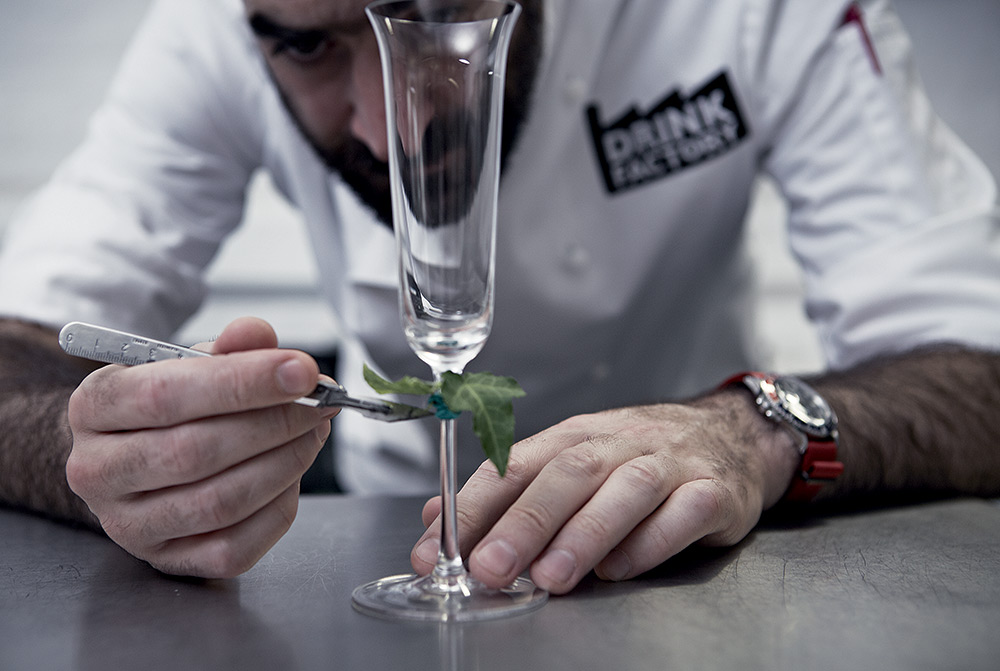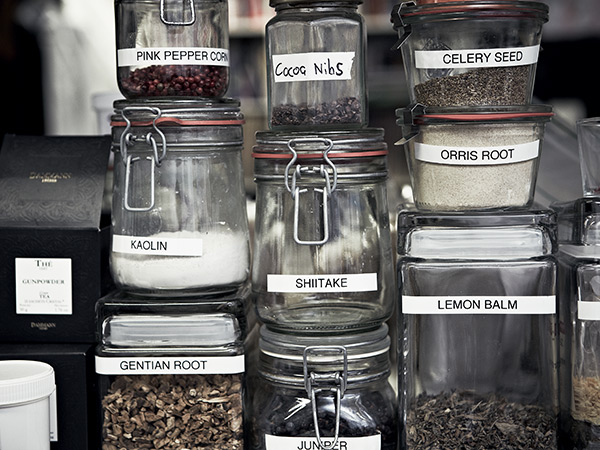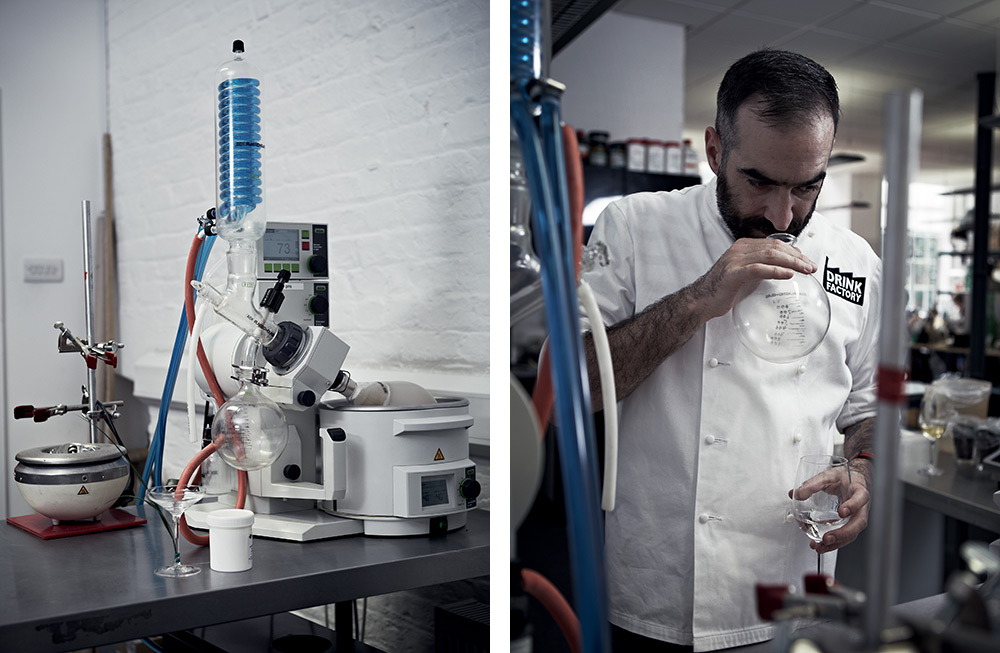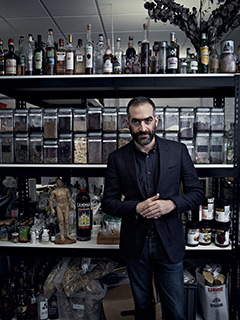Previous Article
Next Article
- AM WORLD
- FEATURES
INTERVIEW

In the MIX
TONY CONIGLIARO IS AMONG A STYLISH CLUTCH OF MIXOLOGISTS SHAKING UP THE LONDON COCKTAIL BAR SCENE WITH WORLD-CLASS CREATIONS
Interview: Dominic Bliss
Portraits: Daniel Thomas Smith
When ordering a cocktail from Tony Conigliaro, you would perhaps be wise not to look too closely at the ingredients. Some of his more infamous creations sound a little unsavoury, to say the least. There's The Terroir, for example, with distilled clay, flint and lichen in it. Or The Flintlock, with gunpowder tea and dandelion bitters. Others contain patchouli, hay, cedar wood, smoked frankincense, mustard vodka, shallots, even the bile from a sperm whale.
Nothing to worry about, though. The 42-year-old Conigliaro, one of London's most celebrated cocktail barmen-or mixologists, as they're known-insists every one of his drinks has been rigorously tested and tasted by qualified scientists. And judging by the popularity of his three London cocktail bars (The Zetter Townhouse, 69 Colebrooke Row and Grain Store), they have all passed with flying colours.
The nerve centre of Conigliaro's operation, Drink Factory, is housed in the former north London recording studios of rock band Pink Floyd. Here he presides over a whole chemistry lab of scientific equipment ranging from stills, freeze-dryers and centrifuges to a vacuum distillation unit and an ultrasound mixer. On the shelves are jars of herbs, seeds, nuts, flowers and tree barks, all eventually destined to arouse a drinker's palate.

Tony's Aston Martin cocktail
If Aston Martin had its own cocktail, it would surely be racing green in colour. Conigliaro suggests a drink he calls the Ivy League. It involves making a food-grade perfume from pistachio, petits pois and petitgrain, then mixing this into a Champagne cocktail. "It's rare to get drinks with a real, green freshness to them," Conigliaro says.
"We take all these ingredients," says Conigliaro, "and we distil them, freeze them, macerate them, boil them up, blend them, centrifuge them. Whatever's appropriate to the ingredient and its flavour. Sometimes we just let them be." It's a process known as molecular mixology, although Conigliaro bridles at the term. "It doesn't really describe what we do: the bar service, the hosting, how we treat our guests, how we present the drinks. The term mixology implies we're just putting a series of flavours together."
Despite his tattoos and black beard, he could pass for some sort of mad Victorian professor, hunched over his Bunsen burners, test tubes spilling over with fumes. "Actually, I'm not a scientist by any means," he says. "It's a bit more mundane than that. The crazy professor part is a minor thing compared to the more artistic side of what we do."
See this mixologist in action, and you realise how much skill, experimentation, even love, goes into creating cocktails. As Conigliaro writes in his 2012 book, Drinks: "Bartending is a craft. The passion and dedication I put into each cocktail can span months, and on occasion, even years. I don't believe in cobbling stuff together. I refine things, test things, make them 100 times over, to push the limits until I achieve exactly what I set out to."

Tony Conigliaro's Drink Factory boasts a range of scientific equipment.
Many of his cocktails start with a story: "We create a mythology within the drink; we like to create a narrative, almost a stage set, behind each drink."
Take his creation The Rose, for example. Conigliaro explains how, as you sip this, you should imagine you are walking into a rose garden with a glass of Champagne. "The deeper you get into the garden, the heavier the smell of the rose; the more pungent and sexual it becomes. I suppose it's a metaphor for the story of seduction."
He is also working on a series of cocktails based on the idea of poison, to tie in with the story of Great Aunt Wilhelmina, the fictitious owner of his Zetter Townhouse bar. He plans to use "bitter and intense" flavours to represent the way Wilhelmina supposedly poisoned her second husband.
"Playing on mythology means we can create a refuge or suspension from reality," he writes in his book. "Which is exactly what drinking and bars are about. You go to a bar to get away from the craziness of everyday life."
“Cocktails have enjoyed a huge resurgence in recent years. If pre-Prohibition United States in the early 1900s was the heyday for mixing classic drinks, then right now must be a second golden age. There are various theories for this renaissance. Conigliaro points to the plethora of cocktail recipes and drink-mixing instruction in magazines, newspapers and on the internet. He praises the numerous cocktail classes available for ordinary drinkers, and the competitions and awards that recognise the skill of his profession. (He himself has received many such awards.)
Other experts suggest that cocktail culture simply went into hibernation for most of the 20th century. Prohibition, in 1920, was the killjoy that first called time at the bar. All across America mixology skills withered as barmen in speakeasies were forced to use low-quality bootleg liquor. There were pockets where cocktails still flourished (notably London and Paris) but, worldwide, drinks lost their panache.
Even in the early 1930s, when Prohibition was repealed, the global drinks industry failed to revive the cocktail culture that had been so dominant before World War I. Then came the mass production of spirits in the 1950s, the dominance of vodka in the 1960s and 1970s, and the deluge of novelty drinks and the dreaded cocktail umbrella in the 1980s. Drinkers had to wait until the turn of the millennium before mixology entered its second golden age. But the rise of mixologists is also no doubt linked to the recent revolution in global cuisine. Conigliaro points out how, over the past few years, cocktail barmen have craved the same respect that chefs have achieved. "Bartenders want to be elevated, too. They don't want to be left behind."
He also believes that London is spearheading this resurgence in cocktails. "Great bartenders from all over the world come to London," he says. "First they were Australian. Then South African, Polish, Brazilian. That international culture helped the UK become one of the leading countries in cocktails." He stresses how the days of "bloody strong and sweet drinks" with cocktail umbrellas protruding rudely out of them are thankfully long gone. Nowadays, it's more about a sophisticated, James Bond-style image of mixed drinks.

Conigliaro's training is in fine art and art history rather than bartending. At his London art school he specialised in painting, but with an unusual twist: he mixed aromas into the paint-"a kind of advanced scratch and sniff," he jokes. After graduating, he found he was struggling to pay rent on his artist's studio so he earned extra cash at a "low-end cocktail bar" run by a friend. "I started off just cleaning glasses," he remembers. "Then I learnt about drinks, and the history of drinks. And it snowballed from there."
It certainly did. Over the following years, he shook and stirred drinks in a long list of bars, winning an ever longer list of awards. What places him well in the vanguard of mixologists is his appreciation of flavour. Growing up in an Anglo-Sicilian family, he says he was always immersed in "flavour-packed home cooking". One of his favourite dishes to prepare is wild mushroom risotto "because the devil really is in the detail".
He also knows exactly how alcoholic drinks interact with the human olfactory system. "At the back of your palate is the epiglottis, which is open when you breathe," he writes in his book. "When you swallow, it closes so that the liquid doesn't flow down into your airways. When it reopens, it releases a reflux of aroma molecules back into the olfactory chamber, so when you're tasting something, you're really smelling it. Therefore, the majority of taste is smell and this is also why the way in which we enjoy cocktails can have much in common with how we enjoy perfumes as well as food."
Sure enough, on the shelves next to his laboratory are dozens of perfume bottles. The processes by which Conigliaro and his team produce their cocktails aren't dissimilar to the way perfumers create their fragrances. Only these ones are designed to be splashed down throats rather than on to them.
Alongside the perfume bottles is a jungle of test tubes, pipettes, bell jars, drinks shakers, swizzle sticks, food blenders, and every size and shape of cocktail glass you can imagine. Beyond this, rising as far as the ceiling, are dozens and dozens of bottles of booze. Just imagine the office parties they throw here.
On the laboratory wall is a white board with Conigliaro's latest drink recipes scrawled in marker pen on it. He gives strict instructions that no cameras are to be pointed in the direction of this board. Even in drink-making, trade secrets must be closely guarded.
Not surprising, really. Conigliaro is at the cutting edge of cocktail-making, now designing the types of drinks that trendy Londoners will be consuming in years to come. And he's confident the cocktail industry has a healthy future ahead of it. "Drinks will become more simple in their presentation," he says when asked how this second golden age of cocktails is going to develop.
"More Scandinavian minimalism rather than all-singing, all-dancing drinks. And more bespoke ingredients. I think people are looking for very clean, pure flavours. At the end of the day, we want the drinks to be able to speak for themselves."
Previous Article
Next Article
- AM WORLD
- FEATURES
